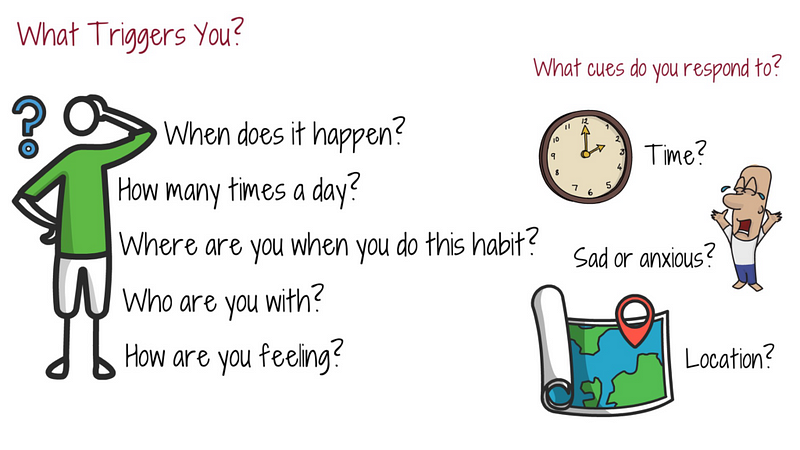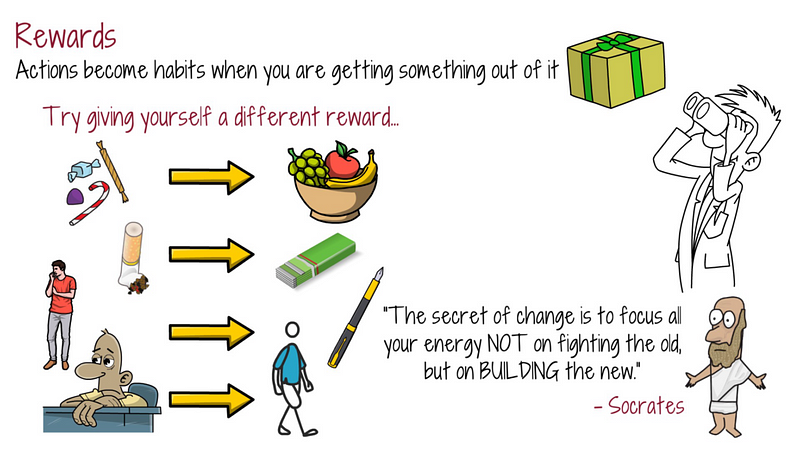Transforming Bad Habits: Strategies for Lasting Change
Written on
Identifying Your Bad Habits
Do you find yourself struggling with a bad habit or two? You're not alone. While cultivating good habits can lead to a fulfilling and healthy life, bad habits often hinder our progress toward our goals and the person we aspire to be.
You might think that simply stopping a bad habit would be straightforward. However, as many people can attest, it's often much more complicated. The deeper the roots of a bad habit—especially if it's physically addictive—the tougher it can be to eradicate. A more effective approach might be to transform that bad habit into a positive one.
So, how can you successfully change a bad habit into a beneficial one?
Awareness is Key
The first step is to evaluate your daily routines and habits. Recognize which habits serve you well and which do not. Identifying your negative habits is essential for initiating change. We all possess both positive and negative habits, and the distinction lies in whether they contribute positively or negatively to our well-being.
Good habits are those that enhance our health, improve our work quality, and nurture our relationships. In contrast, bad habits can create obstacles that prevent us from reaching our goals. If a habit undermines your health, leads to procrastination, or has other adverse effects, it may be time to consider a change.
According to author Jack D. Hodge, “Habits are important… Up to 90% of our everyday behavior is based on habit.” Many of our habits have become so ingrained that we often perform them without conscious thought. While some habits, like brushing our teeth or tying our shoes, are beneficial, others—such as smoking or stress-eating—can be detrimental despite their ease.
Understanding Your Triggers
Once you've identified the habit you wish to change, reflect on its nature by asking yourself several questions:
- When does it occur?
- How frequently does it happen each day?
- Where are you when you engage in this habit?
- Who are you with?
- What feelings accompany this behavior?
Analyzing the cues that prompt your actions is crucial. Does the habit correlate with specific situations or emotions? Are there particular locations that trigger the urge to indulge in the habit?
Every habit consists of three components: the trigger, the action, and the reward, which together form a habit loop. For example, if you feel anxious when receiving a call from your boss, and that anxiety leads to nail-biting, the anxiety serves as the trigger. Similarly, if you light up a cigarette after a meal, finishing your food acts as the trigger.
While avoiding certain triggers might be beneficial, it's not always practical. For instance, one cannot simply skip meals to avoid the urge to smoke afterward. Relying solely on willpower often yields only temporary success, as it tends to wane over time.

Disruption and Replacement
The next phase in the habit loop is the action itself. It’s generally easier to swap out a bad habit for a healthier one than to eliminate the behavior entirely. By adjusting your approach or making different choices, significant positive changes can occur.
For instance, if your mood—like stress or anxiety—triggers the urge to snack on chips or cookies, consider what healthier alternatives you might enjoy instead. Could you reach for an apple or another nutritious snack? By substituting a harmful habit with a healthier choice, you can still achieve a similar reward without completely denying yourself.
If cookies are too tempting, consider not keeping them in your home. Research has shown that restricting the visibility of cigarettes, for instance, led to a reduction in sales.
Our brains appreciate simplicity. If you habitually check your phone in bed, try leaving it in another room. Altering your environment can significantly influence your habits.
Reinforcing Positive Rewards
Your actions become habitual because they provide some form of reward. However, you can harness this reward system to combat bad habits by offering yourself alternative rewards.

For instance:
- Swap out processed sweets for fresh fruit.
- Replace cigarettes with gum.
- Use journaling instead of nail-biting.
- Opt for a walk when boredom strikes.
Using these replacement techniques can help turn negative habits into positive ones. Philosopher Socrates wisely noted, “The secret of change is to focus all your energy NOT on fighting the old, but on BUILDING the new.”
Commitment to Long-Term Change
Creating a new lifestyle habit can lead to a transformed self. While it's relatively simple to give up something temporarily, making a lasting change requires a commitment to a new way of living.
Psychologist Wendy Wood states, “Your brain requires up to three months of daily repetition to develop the neural pathway that automates a behavior.” Thus, changing a habit is a gradual process. However, once you identify what you want to change and embark on that journey, you can achieve meaningful results over time.
By understanding the habit loop, you can devise a new strategy and observe the outcomes. This process can be applied to any habit you wish to modify.

Best-selling author and motivational speaker Denis Waitley captured it well: “The truth is, you don’t break a bad habit. You replace it with a good one.” By altering your reactions to triggers and replacing them with constructive actions and rewards, you can enact enduring lifestyle changes.
Persistence is vital in this endeavor. It takes time to form new neural pathways, but once your brain adapts to the new routine, it can further solidify it with additional positive habits.
Benjamin Franklin advised, “It’s easier to prevent bad habits than to break them.” By being mindful of the habits you cultivate initially, you can more easily maintain positive behaviors and transform those you wish to change.
Strategies for Change: Expert Insights
The first video, "How to Change BAD HABITS and Become A BETTER YOU w/ Charles Duhigg," provides insights on effectively transforming your habits for a better life.
The second video, "How To Change Your Bad Habits - The Easiest Way," discusses practical methods for changing negative behaviors effortlessly.